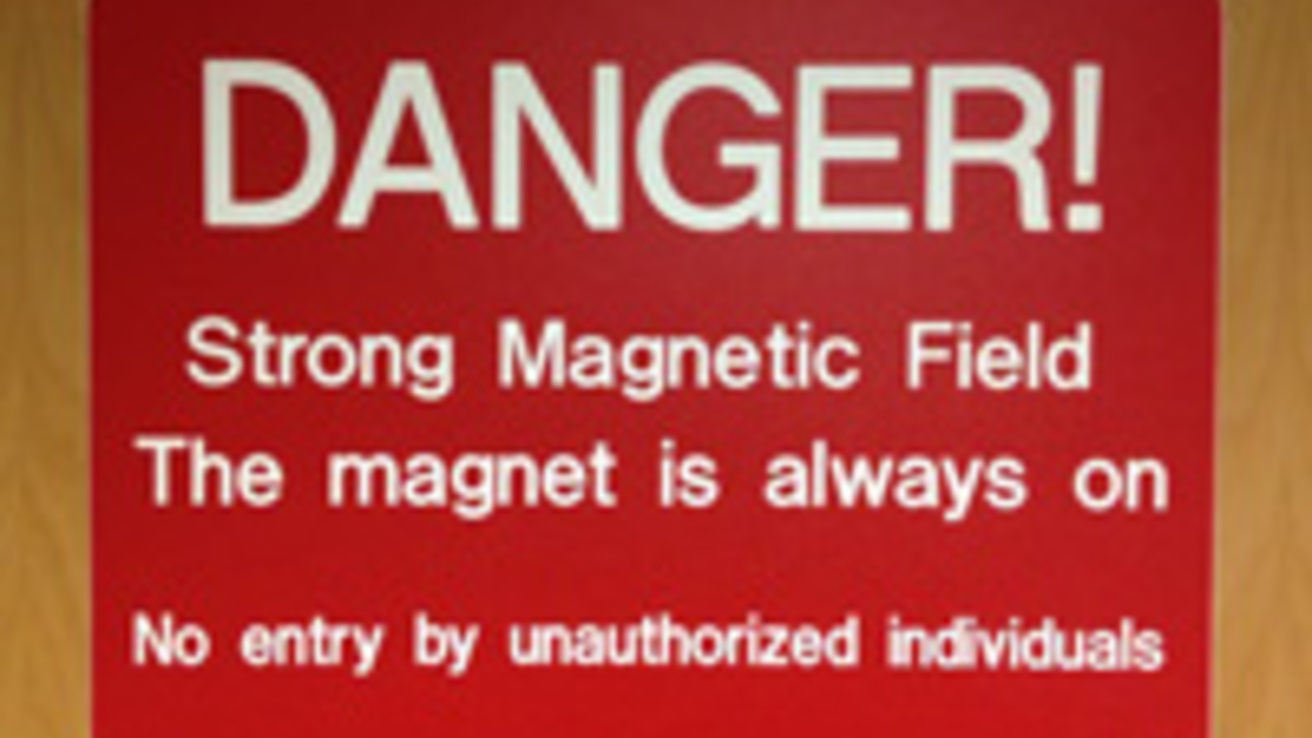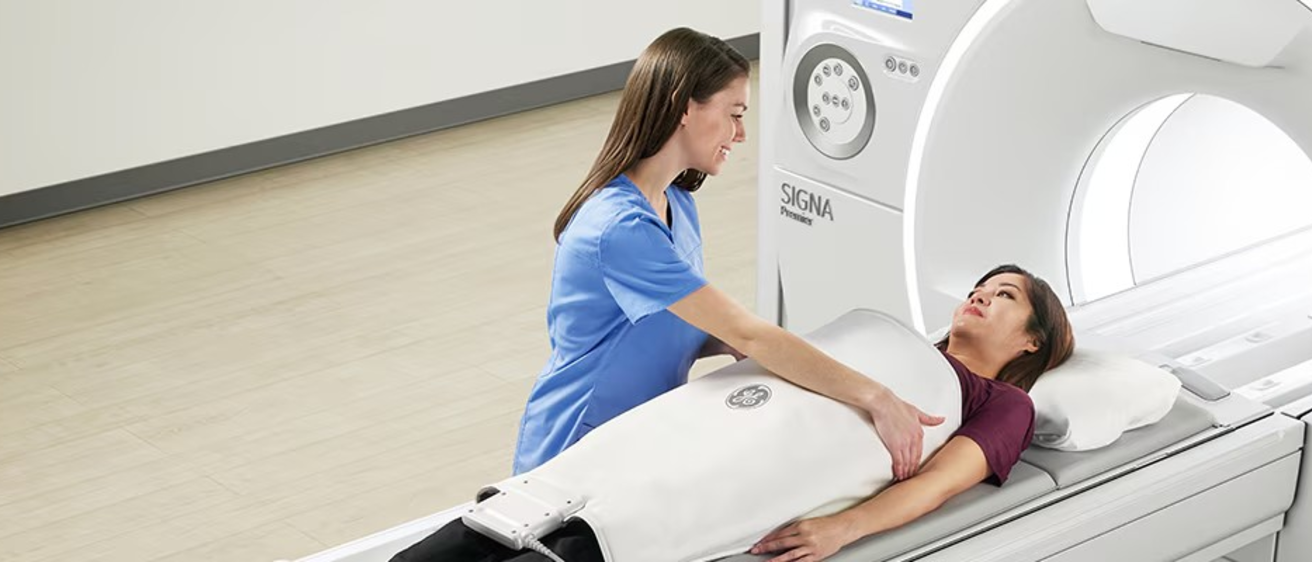The MRI magnet is ALWAYS on. This means no person is allowed to enter the MRI scan room without clearance and permission from a certified technologist. Metallic objects (such as fingernail clippers, pocket knives and even pens) can lead to serious bodily injury if brought within the magnetic field.
Projectiles are one of the biggest dangers associated with the MRI scanning environment and occur when the strong magnetic fields of the MRI magnet attract ferromagnetic (metal) objects which then become airborne. Even small objects such as paperclips or scissors can be quickly jerked from your hands and severely injure anyone nearby. Metallic objects in the body can also have dangerous effects when placed in a magnetic field. Some metal implants, including some metal fragments, may move inside the body causing internal injury.
All potential MRI research subjects must be screened for items that may be hazardous to themselves or others prior to entering the MRI scan room. It is strongly recommended that anyone involved in the recruitment of MRI research subjects include all items from the MRI Screening Sheet found below when screening subjects.
EMERGENCY CONTACT INFORMATION
Medical Emergency at PBDB
Dial 9, then 9-1-1
Your location is 169 Newton Rd.
The suite is L425 in the Pappajohn Biomedical Discovery Building (PBDB)
The lab phone number is 319-335-8706
Medical Emergency at Hospital
Call 1-9-9
Your location is 200 Hawkins Drive
Clinical MRI Suite - 0400 John Colloton Pavillion (JCP)
The phone number to the main desk is 319-356-2236
MRI Suite Safety Rules
- Only certified persons may operator the Scanner.
- Members of the research team must be present during scanning.
- Anyone (including researchers and assistants) entering the scanner room must sign a screening form.
- Anyone entering the scanner room must first "de-metal" outside the magnet room.
- MRI Personnel must be notified of any questions regarding a subject's compatibility.
- Subjects rescanned on a different day must have a new screening form filled out.
- Subjects must sign the appropriate consent and screening forms before they are imaged.
- The scanner bed will not support subjects weighing more than 450 pounds.
Contact MRI staff at 319-335-8706 for more information.
Other Resources:
Contraindications of the Research MRI Procedure
Nothing should enter the examination room that can be attracted to a magnet. All persons entering the examination room should review and identify any possible contraindications prior to entering the MRI scan room. Please fill out the MRI Screening Sheet before the patient is scanned. MRRF Unsafe Implants
Absolute Contraindications
- Cardiac Pacemaker
- Implanted cardiac defibrillator
- Internal pacing wires
- Clips such as cerebral, carotid, or aortic aneurysm
- Cochlear implants
- Any implant held in by magnet
- Swan-Ganz catheter
- Pregnant/possibly pregnant
Possible Contraindications
- Body piercings
- Tattooed makeup (eyeliner, lips, etc.)
- Dentures
- Hearing aid? (remove before MRI)
- Ocular implants
- Artificial limb
- Joint replacement
- Metal rods or plates in body
- Metal or wire mesh implants
- Vascular access port of catheter
- Transdermal delivery system (Nitro)
- Vascular access port of catheter
- Metal removed from your eye
- Any metal fragments
- Shunt (spinal or intraventricular)
- Any type of prosthesis (eye, penile, etc.)
- Heart valve prosthesis
- Insulin or other drug infusion pump
- Neurostimulator/Bone growth or fusion stimulator
- Intravascular stents, filters, or coils
- Electrodes (on body, head, or brain)
- IUD or Diaphragm
- Hospitalized
- Surgery

New User MRI Training Program
Introduction:
The MR machine is a very powerful magnet that can pose a threat to both investigators and subjects if metallic objects become projectiles, or if a subject has metal inside their body, such as a pace maker or aneurysm clip. In addition, the use of the MR scanner requires an adequate level of understanding to perform proper research on the scanner. Technicians are available both peak and off-peak hours to operate the machine, and investigators are encouraged to make use of their expertise. However, researchers can be certified to work the scanner. To minimize risks, and in order to maintain quality assurance, the following certification procedure has been developed for certified MRI Research Facility staff, such as technologists, to administer to new users.
Certification Procedure:
Tour the MRI Facility and learn about potentially hazardous areas.
The user will be a given a full tour of the MRI Research Facility including the control room, scan room and equipment room. A brief introduction to the equipment will be given and a general overview of MR physics will be provided if required. While the main hazard in MR is the strong magnetic field, there are other potential hazards such as high voltage equipment and subjects who become claustrophobic. Each of these issues will be highlighted on the tour.
Watch the MRI safety video.
The MRI Research Facility has a safety video. New users will be required to watch the video to make them aware of the potential dangers associated with the MR scanner.
Review checklist of items that must be completed when scanning a subject.
This is a list of 20 to 30 items that must be completed by the user for each study. Some of these items may seem trivial, but are required to minimize subject risks, control loss of data, and to maximize the quality of data acquired.
Receive demonstration of the scanner in use.
MRI staff will run a scan from beginning to end. An overview of how to screen subjects, place the subject on the scanner table, landmark, and scan the subject will be provided. This process includes an overview of the scanner system software and how to archive data.
Receive demonstration of fMRI equipment operation.
Staff will go over where the stimulus computer is located, how to turn on the projector, where the manipulandums are kept, how to start BIOPAC, and how to troubleshoot equipment errors.
Establish correct scanning procedures - 8 hours.
The user will be required to observe a technologist run the scanner and operate it themselves for a period of not less than eight hours. This allows the MRI Research Facility to evaluate a user’s ability to operate the machine. This is an indefinite process and will only be completed once the technologist feels the user has an adequate understanding of how to operate the machine, is aware of and will take appropriate steps to minimize adverse event, and is capable of collecting high quality data.
Receive Certification.
Certifying the user allows them to operate the MR scanner without supervision from another certified user. Certification is an understanding between the MRI Research Facility and the user that he or she has been trained to operate the MR machine and that they have been made aware of the safety concerns relating to the scanner.
In addition, both the user and faculty member bearing responsibility for the user is accepting full responsibility for any adverse events that may occur while the user is operating the scanner. There will be random checks on the user’s ability to operate the scanner. If it is felt they are making errors or using judgment that may endanger themselves, others, or the quality of the images, the user’s certification can be revoked. This will occur in a written letter to the user stating this fact.
